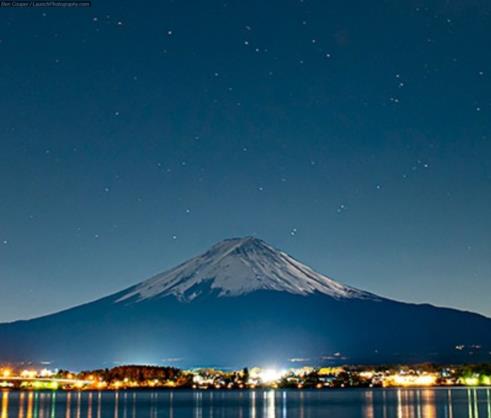
NavList:
A Community Devoted to the Preservation and Practice of Celestial Navigation and Other Methods of Traditional Wayfinding
From: Frank Reed
Date: 2023 Nov 25, 16:07 -0800
Tonight Ben Cooper, a highly-accomplished space launch photographer, posted a "vacation" photo from Japan. It's the Moon and a sky full of stars behind Mt. Fuji. I'm attaching a segment of the photo to this NavList post. The full photo is gorgeous, and if you're on Facebook, you can find it on his FB page: https://www.facebook.com/LaunchPhoto. His website, https://www.launchphotography.com, also includes some impressive astrophotos, but I didn't see this recent image with Mt. Fuji.
I looked at the photo quickly tonight and noticed a nice little string of stars including a couple of pairs rising like a thin stream of smoke from the mountaintop. Well whaddayaknow! That's Grus. The string of stars really is prominent. I have copied my description from the first post in this thread below... And where is Alnair?
Frank Reed
Back on October 31, I wrote:
The navigation star Alnair (formerly spelled Al Na'ir in the official Nautical Almanac star list) is moderately bright but not well-known in northern latitudes since its Dec is nearly -47°. Yet even from my latitude in southern New England where it barely makes it above the southern horizon when transiting the meridian, it happens to be relatively easy to identify thanks to the "neck of the crane". Yes... there's a crane in the sky.
The constellation Grus is a crane, a bird with a long neck, and Alnair is the brightest star in the constellation, and its Bayer designation is α Gruis (that's "alpha" Gruis). Here's a nice photo I came across on Friday. It is tagged as having been taken from Suwarrow Atoll in the Pacific Ocean. After passing right over Machu Picchu in Peru this past Saturday morning, the Sun also passed directly over Suwarrow about six hours later. This is an uninhabited atoll in the mid-Pacific near 163° West and 13° South which is administered by New Zealand.
Notice the string of star pairs near the top of the photo. That's usually identified as the neck of the "crane" in the constellation Grus. Once you've seen them a few times, these are easily spotted in the sky, or in a night sky photo, and they lead directly to Alnair. You may also be able to find the nav star Peacock in the photo of this ornithological stretch of the night sky...







